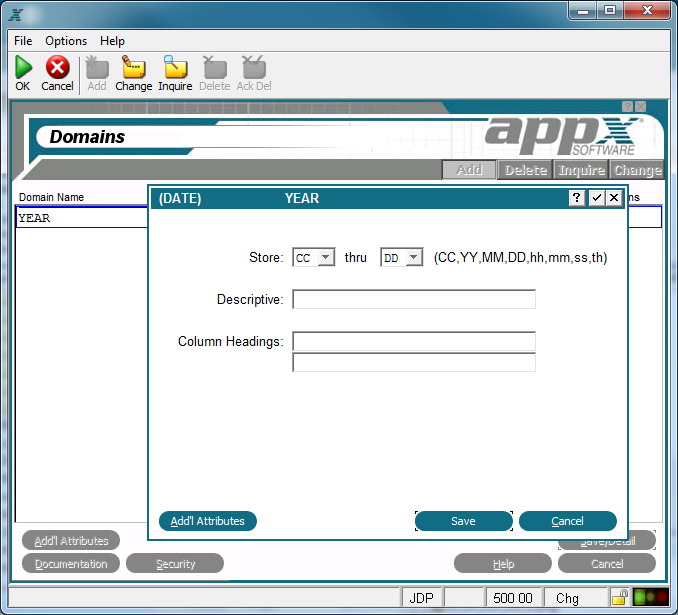Chapter 2-3: Domains |
Date Domains A date domain contains date and/or time information. This information may, at your option, range from a century through a hundredth of a second. Examples of date/time domains include invoice dates, order dates, elapsed time data, date/time stamps used to uniquely identify records. The Date domains overlay, shown below, permits you to add date/time-specific attributes to those already defined for the domain. It automatically displays after you complete the entries in the Domains specifications screen if the type you selected is DATE.
Date Domain Overlay The Date domains overlay contains the following fields: Store thru designates the parts of a date that are physically stored.Valid entries areCC (Century), YY (Year), MM (Month), DD (Day), hh (Hour), mm (Minute), ss (Second), th (hundredth of a second). Descriptive provides a longer, more easily understood alternative to Domain Name, one that is not required to be unique within an application. If blank at all default levels, Domain Name is used. Column Hdgs designates up to two lines of column heading text. The APPX output process facility uses this text to generate standard column heading images for Start of Page and Start of Range class frames. For cosmetic reasons, the length of headings should not exceed the length of a domain itself. Refer to Standard Column Heading Image for additional information. The Date domains Additional Attributes overlay contains the following fields: Default Value - see definition for Default Value under Numeric Domains. Range Checks - see definition for Range Checks under Numeric Domains. Dflt Dspl Msk controls how fields based on this domain appear to a user on an APPX image, unless overridden at the image item level. If left blank, the date mask specified for the application (in Application File Maintenance in System Administration) is used or, if that is also blank, the date mask specified in System Parameters is used. Refer to the Display Mask (Date/Time) section in Using the Character Based Image Editor for additional information about this entry. Storage Type determines the internal storage format of the date field. The Storage Type options for Date domains are: BINARY The date is stored in binary format. PACKED DECIMAL stores two decimal digits for each byte. ALPHA stores the external representation of data. The default is PACKED DECIMAL. |
Application Design Manual "Powered by Appx Software"1001 ©2006 By APPX Software, Inc. All Rights Reserved |
